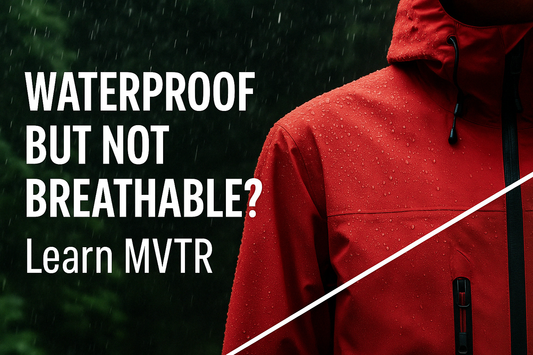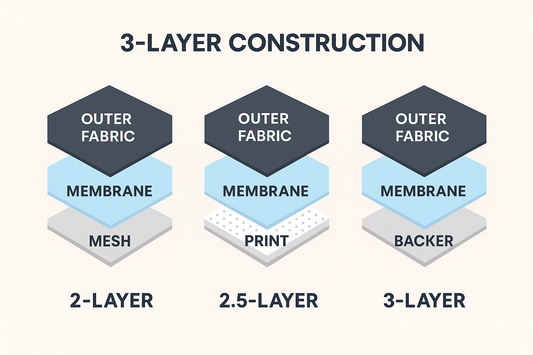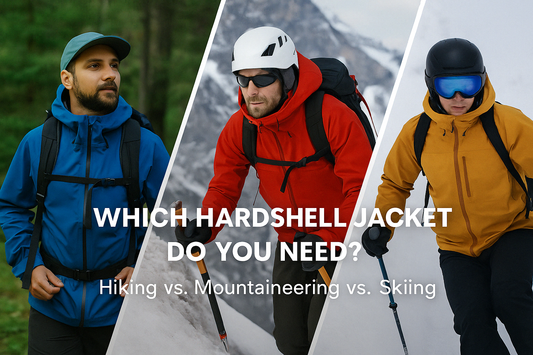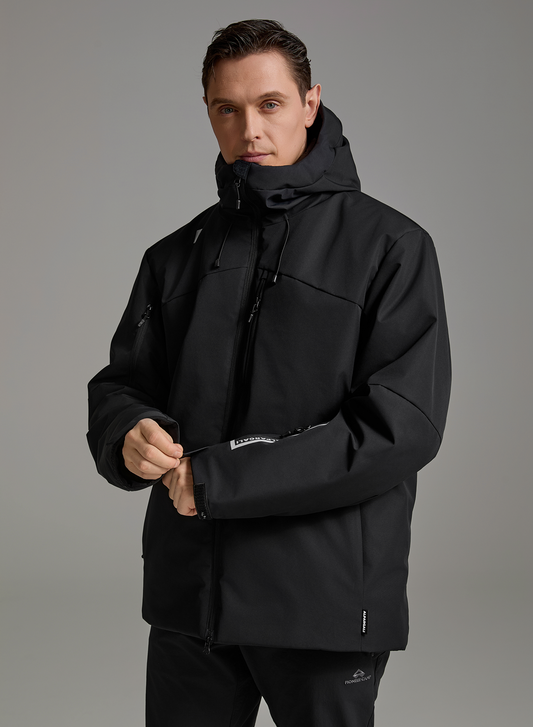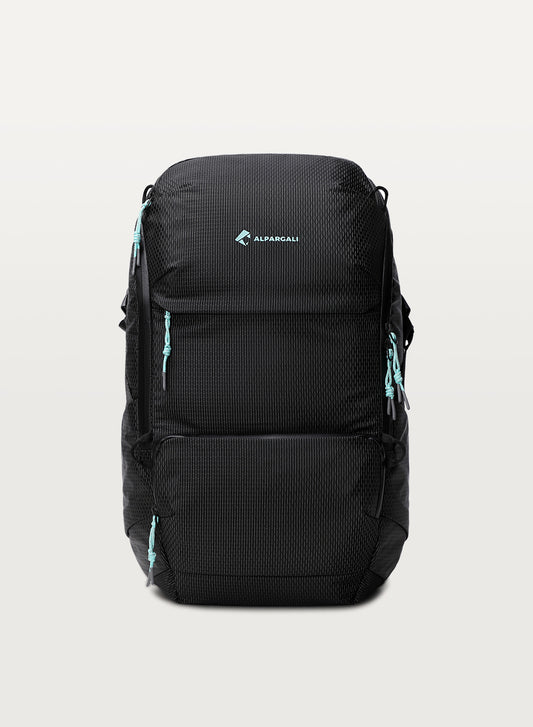
Hardshell vs Softshell Jacket: Which One Is Right for You?
Share
When it comes to outerwear, particularly for those who love the great outdoors, the debate between hardshell and softshell jackets often sparks a lot of opinions. Both styles have their merits, but figuring out which one is right for you depends on a variety of factors.
In this post, we’ll break down the core differences between hardshell and softshell jackets, explaining the pros and cons of each, and giving you the honest, no-nonsense advice you need to choose the best one for your needs. Whether you’re a seasoned adventurer or just getting into outdoor activities, this guide will help you pick the right outer layer to match your lifestyle and outdoor pursuits.
What is a Hardshell Jacket?
A hardshell jacket is a type of outerwear specifically designed to offer complete protection from harsh weather conditions. It is fully waterproof and windproof, making it ideal for extreme outdoor environments.
Key Features:
-
Three-Layer Construction: Hardshells typically have a three-layer design: a durable outer fabric, a waterproof breathable membrane (like Gore-Tex), and an inner lining for comfort. The jacket’s membrane keeps water out while allowing moisture from sweat to escape, ensuring you stay dry and comfortable.
-
Sealed Seams and Waterproof Zippers: Sealed seams and waterproof zippers prevent water from seeping in, even through the smallest openings.
- Rigid Design: Hardshell jackets are generally stiff and rigid, designed to provide maximum protection against the elements, though this makes them less flexible than softshells.
What is the Purpose of a Hardshell Jacket?
A hardshell jacket is designed for extreme weather protection. It's perfect for situations where staying dry and protected from rain, snow, or wind is essential. Whether you're skiing, mountaineering, or backpacking, a hardshell provides the durability and weather resistance needed to keep you safe in harsh conditions.

What is a Softshell Jacket?
A softshell jacket is a lightweight, flexible outer layer designed for breathability and comfort, particularly suited for high-intensity activities. Unlike hardshell jackets, softshells do not feature a waterproof membrane but offer water resistance and wind protection, making them ideal for milder, less extreme weather conditions.
Key Features:
-
Lightweight and Soft Fabric: Softshells are made from stretchy, breathable fabrics, offering comfort and freedom of movement for active outdoor use.
-
Elasticity and Freedom of Movement: Their design prioritizes flexibility, making them perfect for activities that require a wide range of motion, like climbing, hiking, or skiing.
-
Water Resistance: Softshell jackets provide some protection against light rain and snow, but they do not have the waterproof membrane found in hardshells. They are best suited for environments where complete waterproofing is not critical.
-
Brushed or Fleece-Lined Interior: Many softshells feature an inner lining of brushed fabric or fleece, offering a bit of warmth without compromising breathability.
What is a Softshell Jacket Used For?
Softshell jackets are perfect for high-output activities such as cross-country skiing, climbing, or mountain biking, where breathability and mobility are more important than total waterproof protection. They're also versatile enough for everyday outdoor wear or lower-intensity activities, providing comfort and stretch without sacrificing performance.

Difference between Softshell and Hardshell Jackets
Both softshell and hardshell jackets have their own advantages, and picking the right one depends on your activity and the weather conditions. Here’s a quick table to help you compare the key differences between them.
|
Feature |
Hardshell Jacket |
Softshell Jacket |
|
Weather Protection |
Fully waterproof and windproof, ideal for extreme weather |
Good water resistance, but lacks waterproof membrane protection |
|
Best for |
Extreme conditions (heavy rain, high winds, snowstorms), ideal for mountaineering, skiing, etc. |
High-intensity activities (like skiing, climbing), everyday wear, or mild weather |
|
Breathability |
Less breathable, can cause sweat buildup during intense activity |
Excellent breathability, ideal for high-output activities, keeps you dry by wicking moisture |
|
Comfort |
Stiff and rigid, less flexibility for movement |
Soft, flexible, and comfortable, allows freedom of movement |
|
Weight & Packability |
Heavier, bulkier, harder to pack and carry |
Lighter, more packable, easy to carry for long durations |
|
Durability |
Highly durable, perfect for harsh environments |
Durable for most outdoor activities but less so in extreme conditions |
|
Price |
Generally more expensive, especially for high-performance models |
More affordable, offers better value for everyday use |
1. Weather Protection
Hardshell: Hardshell jackets provide superior protection against heavy rain, snow, and wind. With waterproof membranes (like Gore-Tex), sealed seams, and water-resistant zippers, they can handle extreme conditions. Waterproof ratings typically range from 10K to 20K (10,000mm to 20,000mm), making them ideal for wet, harsh environments like mountaineering and skiing.
Softshell: Softshell jackets are water-resistant but not fully waterproof, with ratings ranging from 1K to 10K (1,000mm to 10,000mm). They handle light rain or snow but aren’t suited for heavy storms. Softshells prioritize breathability, flexibility, and wind resistance, making them ideal for active sports in moderate weather, but not for sustained downpours.
Breathability
Hardshell: Hardshell jackets offer breathability through membranes like Gore-Tex or eVent, but they tend to trap heat during high-intensity activities. While features like pit zips or mesh-lined vents can improve airflow, they still perform better in cold weather or low-intensity activities where sweat buildup is minimal.
Softshell: Softshell jackets excel in breathability. Their lightweight, flexible fabrics allow moisture to escape, making them perfect for high-output activities like running, climbing, or hiking. With no waterproof membrane, they offer superior ventilation compared to hardshells, keeping you comfortable during intense physical activity.
Weight and Packability
Hardshell: Hardshell jackets are typically heavier and bulkier due to their three-layer construction and waterproof membranes. While some ultralight options exist, they are generally less compressible and take up more space in your pack, making them less ideal for fast-and-light activities. The added weight is necessary for their superior weather protection.
Softshell: Softshell jackets are lighter and more packable due to their single-layer construction. They are easier to compress and take up less space in your pack, making them a great choice for active sports and mild conditions. Their lighter weight comes at the cost of weather protection but offers excellent mobility and breathability.
Durability
Hardshell: Hardshell jackets are built for long-lasting durability with rigid fabrics and reinforced seams, making them ideal for harsh environments like mountaineering or skiing. The waterproof membranes and DWR coatings ensure they last in extreme weather, though they may show wear with prolonged use in rough conditions.
Softshell: Softshell jackets are less durable than hardshells due to their softer, stretchier fabrics. While they offer good abrasion resistance, they’re not as robust in harsh conditions. They’re great for moderate environments, but for heavy-duty use, a hardshell is typically more durable.
Comfort and Mobility
Hardshell: Hardshell jackets are rigid and can feel stiff, offering excellent weather protection but limited mobility. The “crinkly” sound from the fabric is common due to its waterproof membrane. Some models include stretch fabrics to improve comfort, but they’re still less flexible than softshells.
Softshell: Softshell jackets are comfortable, flexible, and offer freedom of movement. Their stretchy fabric and soft lining make them perfect for high-intensity activities. With better breathability and lightweight design, they excel in moderate conditions and are ideal for active pursuits.
Hardshell vs Softshell Jacket: Which Is More Expensive?
Hardshell jackets are typically more expensive, with prices ranging from $200 to $600, depending on the brand and features. The high cost reflects the advanced technology used for waterproofing, windproofing, and durability. Premium materials like Gore-Tex or eVent and high-performance designs for extreme conditions can push prices even higher.
Softshell jackets are generally more affordable, ranging from $100 to $300. While they still offer great performance in milder conditions, their lack of a fully waterproof membrane and lower material costs make them more budget-friendly. For those who prioritize comfort and mobility over extreme weather protection, a softshell offers excellent value for the price.
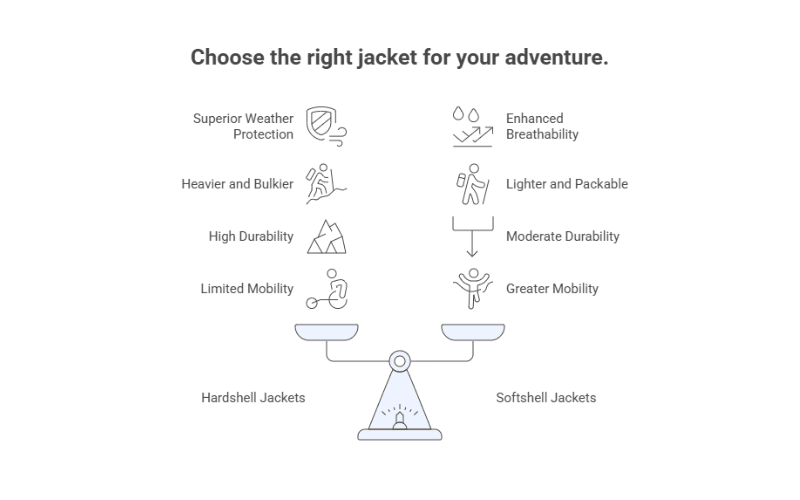
Choosing the Best Outer Layer: Hardshell or Softshell Jacket
When it comes to choosing the right outer layer jacket, it’s all about matching your jacket to the activity and weather conditions. With so many options available, the decision between a hardshell and softshell jacket can be a bit overwhelming. Here’s a simple guide to help you make the best choice for your next adventure.
When to Choose a Hardshell Jacket:
-
Extreme Weather: If you're expecting heavy rain, snow, or high winds, a hardshell jacket is your best option. Its fully waterproof membrane and sealed seams offer top-tier protection from the elements.
-
Backcountry Adventures: For mountaineering, skiing, or trekking in unpredictable conditions, a hardshell jacket provides the durability and protection needed to keep you dry and comfortable.
- Long Exposure: If you’ll be exposed to rain or snow for extended periods, a hardshell will provide all-day protection without compromising on breathability.
When to Choose a Softshell Jacket:
-
Active Sports: Softshell jackets are ideal for high-output activities like trail running, skiing, or climbing. Their flexibility, breathability, and comfort make them perfect for fast-paced, dynamic movements.
-
Moderate Weather: If you’re facing mild conditions with light rain or snow, a softshell jacket is a great choice. It’s water-resistant enough for short bursts of precipitation but not designed for prolonged exposure to heavy rain.
-
Flexibility & Comfort: For those who prioritize comfort and freedom of movement, a softshell offers more stretch and mobility. It’s perfect for active use and will keep you comfortable during intense outdoor activities.
- Budget-Friendly Option: Softshell jackets are generally more affordable, with prices ranging from $100 to $300. They’re a great value for those who need a jacket for moderate conditions and active use, but don't require the full weather protection of a hardshell.
Hard Shell vs Soft Shell Ski Jackets
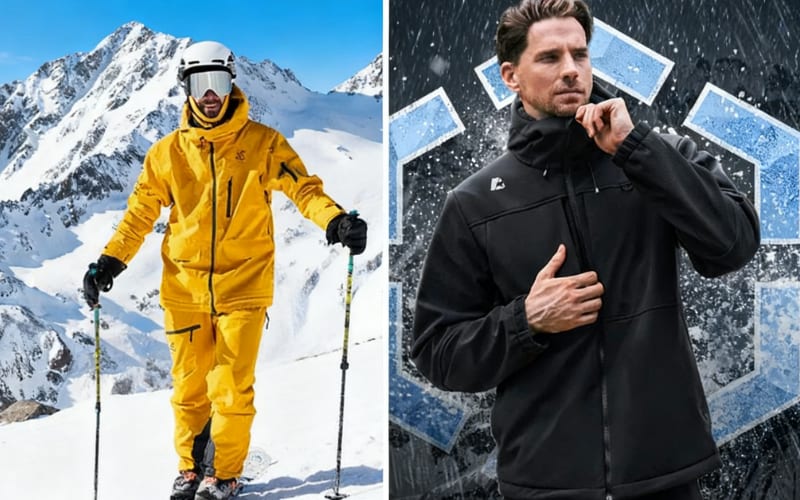
When skiing, the jacket you wear can significantly affect your comfort and performance. Hard shell and soft shell jackets each have their strengths, and understanding when to use each can make a big difference on the slopes.
Hard Shell Ski Jackets: Maximum Protection for Harsh Conditions
Hard shell ski jackets are built to protect you from the toughest weather conditions. These jackets are designed to provide complete waterproof and windproof protection, making them ideal for extreme weather in the mountains.
Best for:
-
Alpine skiing: When you’re skiing in rugged, high-altitude conditions, hard shell jackets are your best defense against extreme weather.
-
Backcountry skiing: For those venturing into off-piste terrain, hard shells offer the necessary protection against snowstorms, high winds, and wet conditions.
- Ski touring: If you’re climbing up before skiing down, hard shells provide waterproof and windproof protection, even if the weather turns nasty.
Soft Shell Ski Jackets: Flexibility for Active Skiers
Soft shell ski jackets are designed for skiers who need mobility and breathability. Unlike hard shells, soft shells provide light weather resistance and excellent flexibility, making them a great choice for high-intensity activities.
Best for:
-
Cross-country skiing: If you’re covering long distances or working up a sweat on flat terrain, a soft shell gives you the flexibility and breathability you need.
-
Freestyle skiing: For those who love doing tricks, jumps, and quick movements on the slopes, a soft shell provides the mobility you need without feeling restricted.
- Milder weather skiing: If you're skiing in cool, dry conditions or light snow, a soft shell will keep you comfortable without overheating.
Hardshell and Softshell Jacket Recommendations
Here, we’ve highlighted one recommended product for each type of jacket to help you make the best choice for your outdoor adventures.
Best Hardshell Jacket: Arc'teryx Beta AR
If you’re someone who thrives on pushing the limits of nature—whether it’s alpine skiing, backcountry skiing, or mountaineering—you need an outer layer that can withstand the harshest of conditions. That’s where the Arc'teryx Beta AR truly stands out.
Designed to handle the toughest environments, this jacket excels in both waterproofing and breathability, ensuring you stay dry and comfortable even in blizzards, strong winds, and wet conditions. Whether you're navigating through snowstorms in the mountains or battling extreme weather, the Beta AR offers full protection with its Gore-Tex Pro fabric.
This outer jacket doesn’t just keep rain and snow out; waterproof zippers and sealed seams make sure not a drop of moisture gets through. Plus, its excellent breathability ensures that even after a full day of activity in freezing temperatures, sweat won’t make you feel clammy or cold, as moisture escapes efficiently.
Best Softshell Jacket: Alpargali Coreshell Jacket
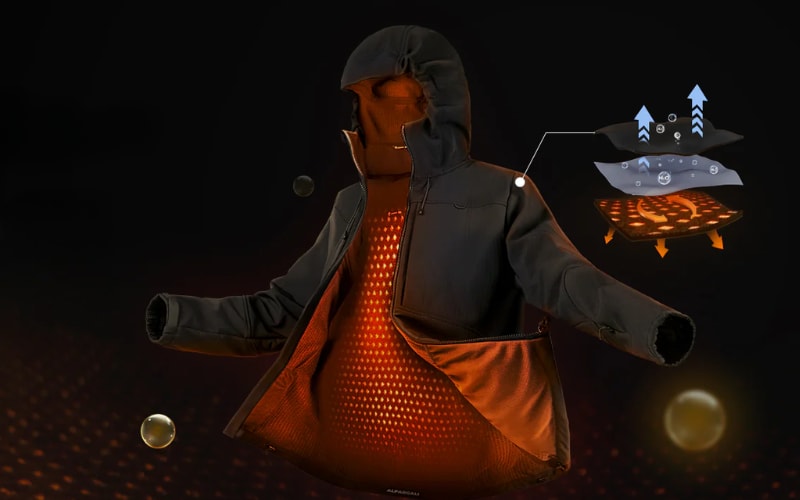
If you’ve been searching for the perfect combination of comfort, functionality, and performance, the Alpargali Coreshell Jacket is here to exceed your expectations.
Unlike other softshells that fall short in warmth, the Coreshell is designed to keep you cozy without the bulk. Thanks to its innovative CoreLock™ insulation and 2mm jacquard fleece, this jacket delivers 30% more warmth than traditional fleece—ideal for those chilly days when you need just the right amount of insulation without overheating.
Whether you’re commuting in the city or hiking your favorite trail, the Coreshell has you covered with its 10K waterproof rating, providing protection against light rain, snow, and wind. Plus, its superior breathability ensures you stay dry from the inside out, no matter how active you get.
With 13 thoughtfully placed pockets, this jacket keeps your essentials secure and easily accessible. From your phone to your wallet, you’ll never have to scramble to find what you need.
And when it comes to the environment, Alpargali is committed to sustainability. Made from 100% recycled polyester and featuring fluorine-free water repellent, this jacket not only supports your active lifestyle but also helps reduce your carbon footprint.
From quick outdoor adventures to daily city wear, the Alpargali Coreshell is as versatile as your life demands, combining sleek style with durable performance. Why settle for less when you can have it all?
The right jacket can make all the difference in your outdoor adventures. Whether you're seeking the rugged protection of a hardshell for harsh conditions or the flexibility of a softshell for active pursuits, your gear should be as ready for the journey as you are. So, no matter the weather or activity, choosing the right outer layer can keep you comfortable, dry, and focused on what matters most—the experience.
Still unsure which shell jacket fits your needs best? Check out our Clothing Comparison page to dive deeper into more jacket options and find the perfect match for your next adventure.
FAQs About Hardshell vs Softshell Jacket
Are hardshell jackets windproof?
Yes, hardshell jackets are windproof. The materials and design, including sealed seams and waterproof membranes, provide strong protection against harsh winds, keeping you warm and sheltered from the elements.
Are hardshell jackets good for winter?
Yes, hardshell jackets are perfect for winter, especially in areas with heavy snow, rain, or high winds. They offer excellent protection against the elements, though you may need to layer them with insulation for added warmth in extremely cold conditions.
Why are hardshell jackets so expensive?
Hardshell jackets can be costly due to the high-performance materials like Gore-Tex or eVent membranes, as well as their durable construction. These jackets are engineered to be waterproof, windproof, breathable, and long-lasting, making them a worthwhile investment for extreme weather conditions.
How do I know if my jacket is hardshell or softshell?
Hardshell jackets are typically stiffer with a smooth outer layer designed for complete waterproof and windproof protection. Softshell jackets are more flexible, stretchy, and breathable, designed for comfort and mobility rather than full weather protection.
What is a hybrid jacket?
A hybrid jacket combines the features of both hardshell and softshell jackets. It uses hardshell materials in areas that need extra weather protection, like the shoulders and arms, and softshell materials in other areas for breathability and flexibility. Ideal for variable weather conditions and high-mobility activities.
